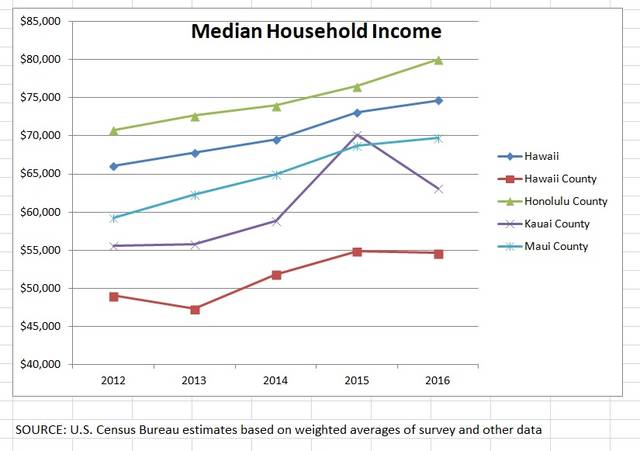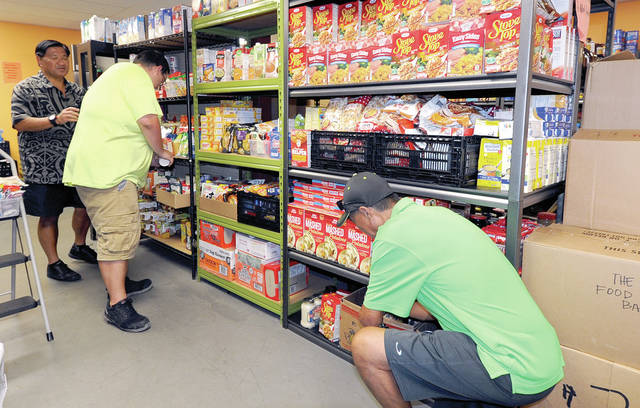Big Island household income falling behind


Marshall Akamu, left, Dustin Williams and Duane Pajimola stock the shelves in preparation for the holiday season at the Hawaii Food Basket. The holidays are always a busy time for the food basket as families trying to get by rely on the provider to help fill their shelves. Hawaii County remains well below the state average median income, according to recent Census Bureau figures. (Laura Ruminski/West Hawaii Today)
It’s long been said a rising tide lifts all boats, but census data released last week shows the Big Island remains grounded on the reef of a faltering economy.
It’s long been said a rising tide lifts all boats, but census data released last week shows the Big Island remains grounded on the reef of a faltering economy.
While the state’s other counties have generally seen steady increases in median household income over the past five years, Hawaii County remains well below the state average and even lost ground in 2016, according to Small Area Income and Poverty Estimates released by the U.S. Census Bureau.
ADVERTISING
The Big Island’s median household income in 2016 was $54,684, compared to $80,012 on Oahu, $69,699 on Maui and $63,164 on Kauai, according to estimates based on weighted averages of surveys and other data. The government uses these estimates to determine qualification for free and reduced school lunches and other programs.
The median is the midpoint in data, with roughly half the values being above and half below that line. The numbers, gathered from aggregated surveys, have various margins of error, but are the best known estimates for the county and state.
The new estimates are no surprise to Mayor Harry Kim, who said he’s acutely aware of how impoverished many of the people are. He cites the fact that whole regions of the island, particularly Puna and Ka‘u, have 100 percent of their schoolchildren in free and reduced lunch programs.
He says the rural nature of the island, where many people depend on an agricultural economy, is one of the factors for what appear to be low wages.
“The only high point is that we have the highest percentage of people who own their own homes,” Kim said, noting the island’s relatively low property values.
Kim said the government has some role in improving the economy, such as by improving conditions for tourists and visitors to the island.
Examples include the revitalization of the Banyan Drive hotel district and constructing sidewalks along Kalanianaole Avenue so cruise ship passengers can more safely make their way to Hilo’s downtown shopping district.
“One of the responsibilities of being mayor is improving the economy of this island,” Kim said. “Almost everything we do is in one way or another related to that.”
Officials for the island’s two chambers of commerce agree that government can help by providing grants and removing roadblocks, but say it can do only so much to bring economic revitalization. The responsibility falls on businesses and business groups to help make it happen, they said.
“Businesses need to take a lead in that. Business is what we do,” said Hawaii Island Chamber president Bill Walter. “We can’t expect government to understand what best needs to be done.”
Business groups on both sides of the island have been brainstorming ideas and are putting some projects in motion to help tackle the issue.
Priorities for the Kona-Kohala Chamber of Commerce include workforce development through education and training at Hawaii Community College-Palamanui and support for STEM fields and technical employment opportunities, said Executive Director Wendy Laros.
“These are ways to increase economic prosperity for the region as well as for individuals and median household income,” Laros said.
One idea being pursued is promoting the island as a great place for businesses where workers can telecommute, said Walter. Programs targeting home-grown businesses include a heavy emphasis on robotics and promoting local businesses through training and contests such as HIplan, which awards $25,000 in seed money for the best business plan.
Puna Councilwoman Eileen O’Hara — whose district includes parts of Pahoa, a town near the bottom of the list with a median household income estimated at just $28,149 — doesn’t think the county administration is doing enough.
“They’re doing nothing as far as economic development,” in her district, she said.
Puna Councilwoman Jen Ruggles, who also represents part of Pahoa, agrees the county’s not doing enough. A good first start, she said, would be to construct a wastewater treatment plant so businesses can grow.
Bringing businesses closer to the large developments would help keep people in Puna, shorten their commute and ease pressure on roads, she said.
“The foundation of economic development is the infrastructure that Puna sorely lacks,” Ruggles said.
Beyond the need for roads and other infrastructure in the state’s fastest-growing district, even a few simple things could help bring businesses back to Pahoa, which lost commerce after the Jan. 16 fire that destroyed the Akebono Theatre and Luquin’s Mexican Restaurant, O’Hara said.
Several businesses have since left because of a critical loss of parking spaces, O’Hara said. She said she’s been asking for months for money to be released from geothermal royalties to pay for security so two existing county parking lots can be opened after hours for customers to nearby businesses.
Census tract estimates in the American Community Survey released Thursday show, apart from a student-housing district near the University of Hawaii at Hilo, the district with the lowest five-year average median household income is Kalapana-Kapoho, with $27,736.
At the other end of the scale is Kawaihae-Waikoloa, with $74,138.
It’s not that workers don’t have jobs — the county’s unemployment rate, while still higher than other counties, is at an almost unprecedented 3.6 percent. But jobs in the agriculture and hospitality sectors tend to be low-wage ones. Even many government jobs pay just $8 an hour, Kim said.
The data showing economic doldrums comes as income levels rise for public-sector workers and top Hawaii County government officials.
All the public employee unions are seeing raises over the next two or five years, thanks to collective bargaining agreements this year. Even larger raises are coming to top county officials, thanks to recent actions by the county Salary Commission.
The two top civil attorneys in the county, the corporation counsel and deputy corporation counsel, for example, will each get a raise Jan. 1 that’s higher than the entire median household income for nine of the county’s 33 census tracts.
Raises for the mayor and council members and some other county officials are expected to be approved at the commission’s next meeting on Dec. 21.
Commission Chairman Hugh Ono doesn’t think the raises are out of whack with the economic realities of the county.
He said the commission took a number of factors into account when arriving at its figures.
Factors included the length of time since the last raises and comparable public- and private-sector salaries, he said. Neither the council nor the mayor have the authority to overrule salaries set by the commission.
“We went through a process,” Ono said. “I’m satisfied with that.”
Median household income by census tract
Kawaihae-Waikoloa 74,138
Hilo: Kahuku-Kaumana 74,112
Holualoa 72,893
Hilo: Kawailani 69,571
Kalaoa 68,333
North Kohala 67,614
Hilo: Haihai 67,017
Waimea-Pu‘u Anahulu 66,842
Kaumalumalu-Keahou 66,771
Hualalai 63,783
Hilo: Piihonua-Kaumana 63,750
Kealakehe 63,497
Konawaena 60,750
Kailua 60,420
Pa‘auhau-Pa‘auilo 60,231
Honoka‘a-Kukuihaele 59,939
Hilo: Keaukaha-Pana‘ewa 57,941
Kea‘au 51,329
South Kona 50,953
Hilo: Puainako 49,368
Pauka‘a-Wailea 47,554
Hawaiian Paradise Park 46,489
North Hilo 45,234
Volcano-Mountain View 44,227
Ka‘u 40,465
Hilo: Pu‘u‘eo-Downtown 37,969
Orchidland-Ainaloa 32,199
Hilo: Upper Waiakea Forest Reserve 31,875
Upper Puna (Puna Mauka) 30,378
Hilo: Villa Franca-Kaiko’o 28,493
Pahoa 28,149
Kalapana-Kapoho 27,736
Hilo: University-Houselots 22,903
(Average value over the 5-year period 2012-2016 in 2016 dollars. Based on survey data.)
SOURCE: Hawaii Department of Business, Economic Development and Tourism analysis of U.S. Census Bureau American Community Survey estimates


